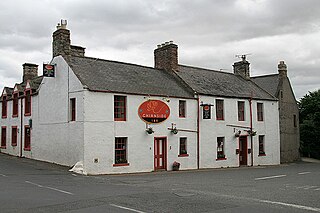
Berwickshire or the County of Berwick is a historic county, registration county and lieutenancy area in south-eastern Scotland, on the English border. The county takes its name from Berwick-upon-Tweed, its original county town, which was part of Scotland at the time of the county's formation in the twelfth century, but became part of England in 1482 after several centuries of swapping back and forth between the two kingdoms. After the loss of Berwick, Duns and Greenlaw both served as county town at different periods.

Warkworth is a village in Northumberland, England. It is probably best known for its well-preserved medieval castle, church and hermitage. The population of Warkworth was 1,493 in 2001, increasing to 1,574 at the 2011 Census.

Chirnside is a hillside village in Berwickshire, Scotland, 9 miles (14 km) west of Berwick-upon-Tweed and 7 miles (11 km) east of Duns.
Sir William Burrell was one of the world's great art collectors. He and his wife Constance, Lady Burrell (1875–1961), created a collection of over 8,000 artworks which they gave to their home city of Glasgow, Scotland, in 1944, in what has been described as 'one of the greatest gifts ever made to any city in the world'. It is displayed at the Burrell Collection museum in Glasgow.

Dunglass is a hamlet in East Lothian, Scotland, lying east of the Lammermuir Hills on the North Sea coast, within the parish of Oldhamstocks. It has a 15th-century collegiate church, now in the care of Historic Scotland. Dunglass is the birthplace of Sir James Hall, an 18th-century Scottish geologist and geophysicist. The name Dunglass comes from the Brittonic for "grey-green hill".

Cockburnspath is a village in Berwickshire in the Scottish Borders. It lies near the North Sea coast between Berwick-upon-Tweed and Dunbar. Cockburnspath is the eastern terminus of the Southern Upland Way as well as the northern terminus of the Berwickshire Coastal Path. At the nearby village of Cove, there is a small fishing harbour.

St Monans, sometimes spelt St Monance, is a village and parish in the East Neuk of Fife and is named after the legendary Saint Monan.

Berwick Castle is a ruined castle in Berwick-upon-Tweed, Northumberland, England.

Foulden is a civil parish and village in the Berwickshire area of Scottish Borders, Scotland, situated not far above the Whiteadder Water, and 7 miles (11 km) west of Berwick-upon-Tweed.

Mordington is an agricultural parish in the extreme south-east of Berwickshire in the Scottish Borders region. It is five miles from Berwick-upon-Tweed and borders Northumberland to the east, and south, Foulden to the west, and Lamberton to the north. The parish is bisected by the A6105 Berwick to Duns road. The lower part of the parish is covered by the Edrington estate. It is possibly the warmest parish in Scotland; the annual hours of sunshine are said to be almost as high as at Dunbar, which records the most hours in Scotland.

Allanton is a small village in the Scottish Borders region of Scotland. Historically part of Berwickshire, for many years it was part of the estate of Blackadder House, which was demolished around 1925.
Paxton is a small village near the B6461 and the B6460, in the pre-1975 ancient county of Berwickshire, now an administrative area of the Scottish Borders region of Scotland. It lies 1 mile west of the border with Northumberland, near Berwick-upon-Tweed. It is a traditional, country village surrounded by farmland, and its closest market towns are Duns and Berwick-upon-Tweed.

Dirleton Kirk is a church in the village of Dirleton, in East Lothian, Scotland.

Chirnside Parish Church is a kirk of the Church of Scotland. It is situated on the B6355 road between Duns and Eyemouth in the old county of Berwickshire, now part of the Scottish Borders, at grid reference NT869560. The town of Chirnside is 6 miles (9.7 km) east of Duns, and 9 miles (14 km) north-west of Berwick-upon-Tweed. Jim Clark is also buried here.

Fishwick is a parish with a small mediaeval village in the Scottish Borders, Scotland, in the traditional county of Berwickshire, seven miles from Berwick-upon-Tweed. The parish church is now a ruin and the parish is united with Hutton and Paxton. Today the parish consists of farms and scattered housing. There is also an old WWII airstrip, still occasionally used. Fishwick borders the north of the River Tweed which here constitutes the border with England.

Edrom is a parish and small village in the pre-1975 ancient county of Berwickshire, now an administrative area of the Scottish Borders region of Scotland.

Hutton Castle is located in the Scottish Borders, overlooking the Whiteadder Water. It stands 2.5 kilometres (1.6 mi) southeast of Chirnside and 11 kilometres (6.8 mi) west of Berwick-on-Tweed. It has also been known as Hatton Hall and Hutton Hall.

Constance Mary Lockhart, Lady Burrell was a Scottish businesswoman, art collector and philanthropist. She was married to Glasgow ship owner and art collector Sir William Burrell. Their collection is displayed at the Burrell Collection museum in Glasgow.
















